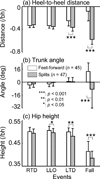Two types of slip-induced falls among community dwelling older adults
- PMID: 22338614
- PMCID: PMC3390203
- DOI: 10.1016/j.jbiomech.2012.01.036
Two types of slip-induced falls among community dwelling older adults
Abstract
Little is known about the landing behavior of the trailing (recovery) foot and ensuing types of falls following a forward slip in walking. The purposes of this study were to (1) determine if community-dwelling older adults experienced bilateral slips at the same rate as had been previously observed for young adults during over-ground walking; (2) determine if fall rate in older adults was dependent on slip type (unilateral vs. bilateral); and (3) identify differences in spatiotemporal variables of the trailing leg step between unilateral and bilateral slips. One-hundred-seventy-four participants experienced an unannounced, unrehearsed slip while walking on a 7-m walkway. Each trial was monitored with a motion capture system and bilateral ground reaction force plates. Although the experimental design, developed with original data from a young adult population, favored bilateral slips, more older adults (35%) than anticipated (10% previously observed in young, p<0.001) displayed a unilateral slip. The probability of fall was equal in the two types of slips. Eighty-two people recovered from the slip, while the remaining 92 (53%) fell. These 92 were classified into two exclusive categories based on the heel distance at the time of fall arrest using cluster analysis: those which resembled a fall into a "splits" position (n=47) or a feet-forward fall (n=45). All (100%) unilateral slips led to splits falls, as expected. Yet, not all bilateral slips (only 83%) resulted in feet-forward falls. A longer forward recovery step with a prolonged step time led to both feet slipping, nearly together, hence a feet-forward fall.
Copyright © 2012 Elsevier Ltd. All rights reserved.
Conflict of interest statement
None declared.
Figures






Similar articles
-
Can Recovery Foot Placement Affect Older Adults' Slip-Fall Severity?Ann Biomed Eng. 2017 Aug;45(8):1941-1948. doi: 10.1007/s10439-017-1834-4. Epub 2017 May 4. Ann Biomed Eng. 2017. PMID: 28474271 Free PMC article.
-
Higher fall rates and broader kinematic diversity in bilateral versus unilateral unconstrained slips.PLoS One. 2025 Aug 7;20(8):e0328900. doi: 10.1371/journal.pone.0328900. eCollection 2025. PLoS One. 2025. PMID: 40773481 Free PMC article.
-
Inefficient postural responses to unexpected slips during walking in older adults.J Gerontol A Biol Sci Med Sci. 1998 Nov;53(6):M471-80. doi: 10.1093/gerona/53a.6.m471. J Gerontol A Biol Sci Med Sci. 1998. PMID: 9823752
-
Biomechanical strategies for mitigating unexpected slips: A review.J Biomech. 2024 Aug;173:112235. doi: 10.1016/j.jbiomech.2024.112235. Epub 2024 Jul 20. J Biomech. 2024. PMID: 39059333 Review.
-
Biomechanics of slips.Ergonomics. 2001 Oct 20;44(13):1138-66. doi: 10.1080/00140130110085547. Ergonomics. 2001. PMID: 11794762 Review.
Cited by
-
A Cross-Sectional Study on Fall Direction and Lower Limb Loading in Response to a Perturbation on Laterally Inclined Platform.Appl Bionics Biomech. 2023 Oct 27;2023:7385119. doi: 10.1155/2023/7385119. eCollection 2023. Appl Bionics Biomech. 2023. PMID: 37928743 Free PMC article.
-
Does stroke-induced sensorimotor impairment and perturbation intensity affect gait-slip outcomes?J Biomech. 2021 Mar 30;118:110255. doi: 10.1016/j.jbiomech.2021.110255. Epub 2021 Jan 17. J Biomech. 2021. PMID: 33581438 Free PMC article.
-
Automatic gait EVENT detection in older adults during perturbed walking.J Neuroeng Rehabil. 2025 Feb 28;22(1):40. doi: 10.1186/s12984-025-01560-9. J Neuroeng Rehabil. 2025. PMID: 40022199 Free PMC article. Clinical Trial.
-
Neuromuscular responses differ between slip-induced falls and recoveries in older adults.J Neurophysiol. 2017 Feb 1;117(2):509-522. doi: 10.1152/jn.00699.2016. Epub 2016 Nov 2. J Neurophysiol. 2017. PMID: 27832608 Free PMC article.
-
Effects of upper body strength, hand placement and foot placement on ladder fall severity.Gait Posture. 2019 Feb;68:23-29. doi: 10.1016/j.gaitpost.2018.10.035. Epub 2018 Nov 2. Gait Posture. 2019. PMID: 30439684 Free PMC article.
References
-
- Bhatt T, Pai Y-C. Long-term retention of gait stability improvements. Journal of Neurophysiology. 2005;94:1971–1979. - PubMed
-
- Bhatt T, Wening JD, Pai Y-C. Influence of gait speed on stability: recovery from anterior slips and compensatory stepping. Gait and Posture. 2005;21:146–156. - PubMed
-
- Bhatt T, Wening JD, Pai Y-C. Adaptive control of gait stability in reducing slip-related backward loss of balance. Experimental Brain Research. 2006;170:61–73. - PubMed
-
- Casalena JA, Ovaert TC, Cavanagh PR, Streit DA. The Penn state safety floor: part II - Reduction of fall-related peak impact forces on the femur. Journal of Biomechanical Engineering. 1998;120:527–532. - PubMed
-
- Cavagna GA, Saibene FP, Santi GF, Margaria R. Analysis of the mechanics of locomotion. Experimental Medicine and Surgery. 1963;21:117–126. - PubMed
Publication types
MeSH terms
Grants and funding
LinkOut - more resources
Full Text Sources
Medical

